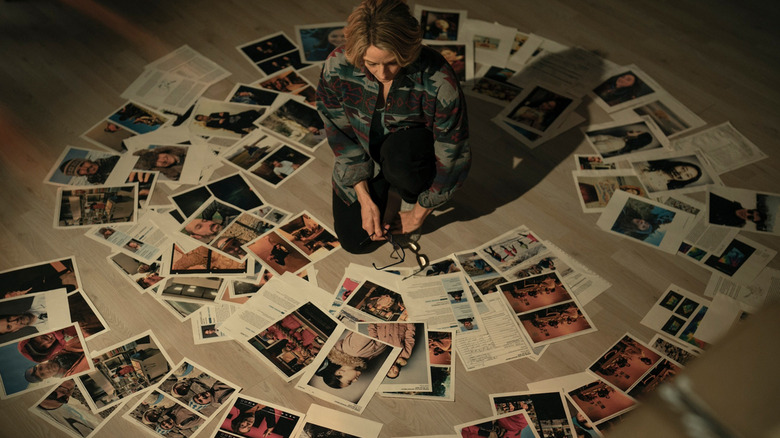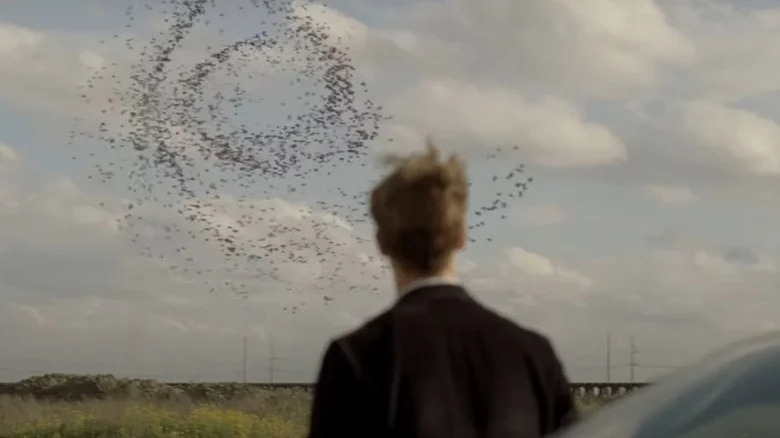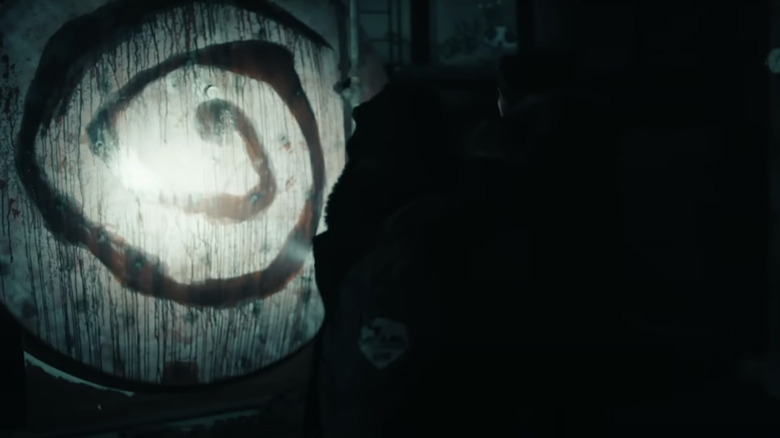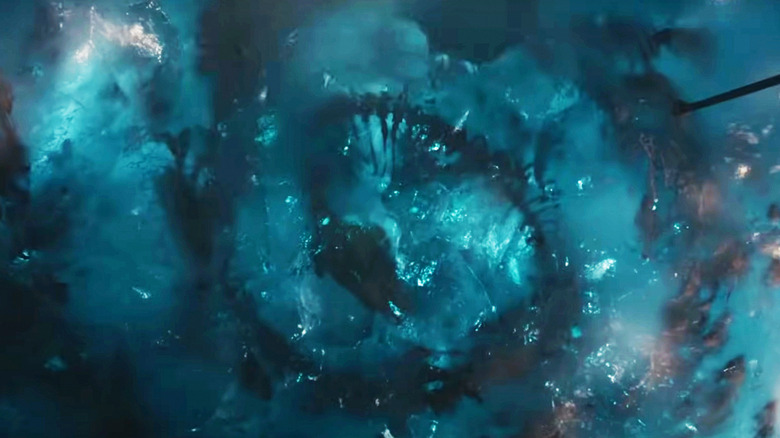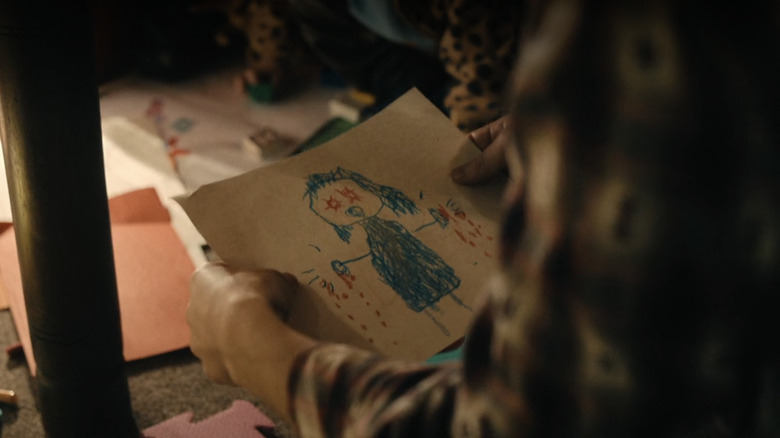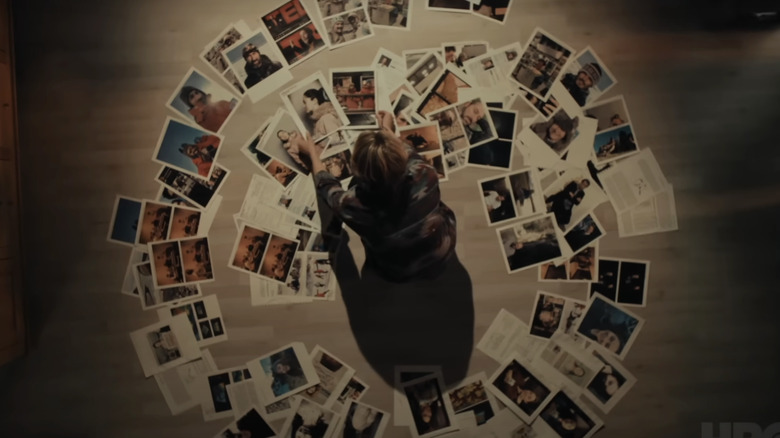The Night Country Finale's Spiral Reveal May Be The Most Controversial True Detective Development Yet
This article contains spoilers for the "True Detective: Night Country" finale.
When "True Detective" aired back in 2014, one of the things that made it so darkly alluring was the folk and cosmic horror element. One of the most salient examples of this was the spiral symbol, which was first seen tattooed on the back of murder victim Dora Lange in the pilot episode. Alas, as the season went on, all we learned about this mysterious motif was that it was somehow tied to the cult responsible for Lange's murder and an ongoing child trafficking operation in Southern Louisiana. That and it seemed to symbolize Rust Cohle's (Matthew McConaughey) famous "Time is a flat circle" line.
After this, show creator Nic Pizzolatto largely ignored the spiral, aside from a brief mention in season 3 of the show. But then, Mexican filmmaker Issa López took over as showrunner, and in 2023, the trailer for "True Detective: Night Country" debuted. And wouldn't you know, it was full of spiral symbols that looked almost identical to those from season 1. Were these spirals just Easter eggs for fans of season 1? Or was there more to it? Now, with "Night Country" coming to an end, we know there was indeed more to it — quite a lot more, actually.
The finale contains what is so far the biggest spiral reveal we've had, yet it somehow raises more questions than answers. This will surely prove divisive among season 1 fans who thought they were finally getting some insight into what the heck this cryptic emblem actually means. But that might be missing the point...
The spread
The most disturbing thing about "True Detective" season 1 was that the cult behind the ritualistic murders was seemingly still operational at the end of the show. The only people brought to some sort of justice were the two serial killers and child abusers responsible for the murders plaguing Louisiana at the time Rust and Marty Hart (Woody Harrelson) were carrying out their investigation. But the cult itself was multi-generational and included members in prominent social and political positions throughout the state. As such, the extent of the cult's influence, which came to be known among online communities as "the spread," remained a mystery.
So, when the "Night Country" trailer debuted and promised the return of the spiral, it signaled that perhaps we were going to finally get some answers as to how far the season 1 rot had indeed spread. Which we sort of did. In "Night Country," we learn that the Tuttle family, the dynasty principally responsible for establishing the cult in season 1, was funding the Tsalal research facility in Ennis, Alaska. This suggested the "spread" was much bigger than fans had initially thought, with the cult previously confined to Louisiana suddenly bankrolling scientific research in Alaska. What's more, in a moment that confirmed "Night Country" as a direct sequel to season 1, officer Peter Prior (Finn Bennett) revealed that the Tuttle family was also funding numerous other ventures, from video games to skincare products.
As "Night Country" continued and the spiral became an increasingly central part of the story, it seemed things were heading in a direction that would ultimately lead to answers about the Tuttle cult. But it slowly became clear that López was very much borrowing the symbol itself and not whatever meaning Nic Pizzolatto had originally intended.
The spiral is central to Night Country's story
Far from merely being an Easter egg, the spiral symbol in "Night Country" has been central to the mystery at the heart of the show. It cropped up in almost every episode, seemingly hinting at the return of the ominous cult from season 1. As things progressed, however, we started to see how López was reinterpreting the spiral, giving this dark symbol a whole new meaning. What made things confusing, though, is that López also included several other allusions to the actual cult from season 1, simultaneously signaling her intent to pick up where Pizzolatto's inaugural season left off and take things in an entirely new direction.
When Liz Danvers (Jodie Foster) encounters the horrific "corpsicle" in episode 2, she sees the symbol drawn on Anders Lund's (Þorsteinn Bachmann) forehead. As things progress, the ominous emblem shows up on the ceiling of Raymond Clark's (Owen McDonnell) abandoned trailer, carved into rocks, and spray painted onto storage tanks in the abandoned dredge. It's all very mysterious, especially with Rose Agineau (Fiona Shaw) telling Evangeline Navarro (Kali Reis) that the symbol is "Older than Ennis. It's older than the ice, probably."
By the time episode 5 rolls around, we get our first semi-explanation of the spiral when Kenny (David Shackelford) explains that it's used as a warning for hunters to stay off thin areas of ice. Fair enough. But what does that have to do with the Tuttle dynasty, and why would the Southern Louisiana family choose to adopt it as a marker for their depraved acts?
The Night Country finale's big spiral reveal
In the "Night Country" finale, Danvers and Navarro uncover the truth about what happened to the Tsalal scientists, who perished in agony on the Alaskan tundra. It turns out they were sent out to die on the ice by a collective of Ennis' oppressed womanhood, who laid siege to the Tsalal outpost in retaliation for the scientists having killed local woman Annie Kowtok (Nivi Pedersen). These vengeful women were taking justice into their own hands after having suffered innumerable injustices as a result of the local mine pumping pollution into their native land. Tsalal, meanwhile, was not only covering up the official pollution figures but pushing the mine to produce more contaminants to make their permafrost excavation easier.
As part of this big reveal, we learn that Bee (Diane Benson) was the one who drew the spiral symbol on Anders Lund's forehead. But the biggest spiral-related moment comes when Navarro and Danvers discover a secret lab below the Tsalal facility. As the pair explore the ice cave, Danvers notices a giant fossil suspended in the icy ceiling — the same fossil that we saw earlier in Annie K's final phone video. Now, however, the full extent of the fossil is revealed. The bones appear to belong to some prehistoric sea creature, which actually forms the center of a large spiral made up of other, smaller fossils and what looks like either rock or solidified pollutants.
This is played up as a big reveal, with the episode cutting straight from the fossil to the opening credits. But this discovery isn't really mentioned again after this moment. So, what does it all mean? Why is Bee drawing spirals on Lund's forehead? And what does this have to do with the Tuttles?
So what exactly does the spiral mean?
Those confused by the final spiral reveal in "Night Country" may, to borrow a phrase from Rust and Danvers, be asking the wrong questions. It seems all the Tuttle talk was a red herring, with López actually priming us for a full reinterpretation of this season 1 symbolism.
When Danvers and Navarro visit Bee and her female cohorts in the finale, Bee explains how the scientists "did it to themselves, when they dug in her home in the ice, when they killed her daughter in there. They woke her up." What exactly is "her?" Well, "Night Country" contains multiple references to the Sedna Inuit creation myth, which tells of a woman who was sent to die on the bottom of the ocean floor after her father jettisoned her from his kayak. (There's a lot more to it than that, but for our purposes, this is all you need to know.) In "Night Country," Sedna is not only referenced directly when Peter Prior's son Darwin draws a picture of what his mother refers to as a "local legend," but she acts as a representation of the natural environment and the oppressed Ennis locals, particularly the women. "Her," then, refers to Sedna, and it seems the fossilized remains in the ice cave ceiling came to symbolize this Inuit goddess for the inhabitants of Ennis.
This is why Bee draws the symbol on Anders Lund's forehead. It's a representation of Ennis itself, and the natural land, fighting back against the blight of modern industry and the pollution it has wrought. The prehistoric fossil in the ice represents this spirit of the land, which is, as Rose Agineau put it, "older than Ennis" and "older than the ice."
Lingering questions about the spiral
While "Night Country" is very much a spiritual sequel to season 1, and even feels like a dramatization of Rust's final line from that season, it's not actually tying up specific loose strings from Pizzolatto's episodes. Instead, López took the symbol and created her own mythology, as represented by the fact the spiral in "Night Country" travels clockwise from the center out, while the season 1 version unraveled anticlockwise. Season 4's spiral is just as potent and foreboding a symbol as its season 1 counterpart, but it's not tied to any child abuse cults or ritualistic murders. Instead, it represents the enduring and often vengeful spirit of the natural environment and of those whose land has been degraded by people who shouldn't be there in the first place.
What's more, López told the official "Night Country" podcast:
"There's a reason that spirals are a warning. Interestingly, when you fall down a spiral, you're also falling down to the center, and sometimes falling all the way down to the center is what you need to find yourself. So yes, there is a lot of catastrophe happening here, but it's the path to discovery."
As such, this new version of the spiral symbolizes something much more hopeful than Rust's "Time is a flat circle" philosophy and actually represents a process of self-discovery. In that sense, the spiral of "Night Country" is about a return to a natural state, both in terms of the natural world and within ourselves. Even if you're a season 1 fan who felt let down by these revelations, you've gotta give it to López for crafting a coherent mythology for her version of the spiral and reinterpreting a classic "True Detective" trope to create something original.
"True Detective: Night Country" is streaming on Max.
